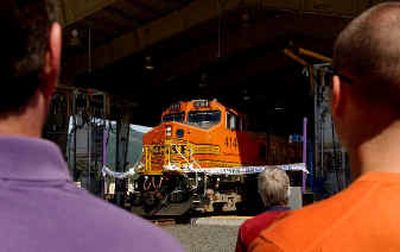BNSF touts aquifer safeguards at depot

RATHDRUM, Idaho – The first locomotive will roll into a new high-speed fueling station on Rathdrum Prairie at 12:01 a.m. Wednesday.
Within 45 minutes, the train will have taken on more than 10,000 gallons of diesel fuel and should be picking up speed on the mainline tracks, heading for a West Coast port or a Great Plains crossing. The $42 million facility – essentially a massive gas station – will shave up to eight hours off a traditional train pit stop, said officials with the Burlington Northern and Santa Fe Railway Co.
The Hauser Mainline Fueling Facility is about four miles north of Post Falls and 150 feet above an aquifer that supplies drinking water to 400,000 people in the Spokane-Coeur d’Alene region. During a grand opening ceremony and public tour Monday, officials showed off safeguards aimed at keeping the fuel out of the ground water.
“We anticipate there will be no leaking into the aquifer whatsoever,” said project manager Kenny Hancock, with the Kansas City-based engineering firm Hanson-Wilson Inc. He added that no engineering project is totally foolproof. “A term I like to use is ‘infinitesimally small.’ Can I tell you it will never happen? No.”
The project generated opposition from citizens groups and some local political leaders when it was announced in 1997. BNSF eventually addressed most of the concerns, said Buell Hollister, a member of two groups that opposed the facility, the Kootenai Environmental Alliance and Friends of the Aquifer.
“I’m satisfied,” he said. “That’s going to be the standard. They’ve set a benchmark now.”
Diesel fuel at the Hauser depot is stored in two 250,000-gallon aboveground tanks. Double-lined steel pipes carry the fuel to an open-air pumping station where up to three trains at a time can be refueled and loaded with water, lubricating oil and traction sand.
BNSF expects to refuel about 25 trains each day – or about half the rail traffic passing on the nearby mainline.
The bottoms of the fuel tanks have two layers of concrete. Buried below the pumping station are two layers of high-density plastic, Hancock said. Combined, the company added about $3.5 million in environmental safeguards above what was required by regulators.
“I have never seen a fueling facility designed with this level of redundancy and protection,” Hancock said.
The railroad’s monitoring plan includes quarterly tests at a nearby well and continual monitoring using a system designed to account for every gallon of fuel that enters and exits the pumps, Hancock said.
Like at any gas station, there will be minor spills. The pumping area has been designed to collect every drop of wasted fuel and water for shipment to a treatment facility in Illinois.
BNSF also agreed to fund a new hydrogeologist position at the Idaho Department of Environmental Quality, said Geoff Harvey, the agency’s waste and remediation manager for the Coeur d’Alene region.
“Our major concern is the protection of the aquifer,” Harvey said. “We intend to be true to what the public wants, and that’s very close oversight of this aquifer.”
Typical annual pay for the depot’s 55 full-time workers will be between $50,000 and $60,000, said BNSF spokesman Gus Melonas.
The fueling depot was built near Hauser because it is near the crossroads of several major rail lines, said Ron Jackson, general manager of BNSF’s Northwest division. Other projects were considered for the site during the 1950s and 1970s, but economic downturns and company mergers scuttled the plans.
The fueling depot is opening at a time of record revenues and double-digit annual increases in freight volumes for BNSF, Jackson said.
At traditional refueling stations in Seattle, Pasco and Vancouver, Wash., locomotives typically are unhooked from the train cars for a trip to the roundhouse.
But the Hauser facility had enough land for 10 miles of new tracks – enough space for three separate trains to top their tanks at the pumping station without unhooking any cars. Diesel is pumped at 190 gallons per minute, which is fast enough to fill a full-sized pickup truck’s fuel tank in the time it takes to read this sentence.
An expected record grain harvest and a continued rise in container shipping will increase demand on the nation’s rail system, Jackson said. “We need to keep locomotives moving.”
Up to 40 trains per day could be refueled during peak shipping season in the fall. The pumping station was designed to accommodate a fourth set of tracks if expansion is needed, BNSF officials said.
Post Falls Mayor Clay Larkin said he worries the extra traffic could translate into higher risk of a spill. More fuel will be coming into the depot in tanker cars, which don’t have the same safeguards as a double-lined tank surrounded by a concrete catch basin. At current demand, BNSF expects to dispense 225,000 gallons of diesel per day at Hauser.
“Our concern was always not immediate. It was down the road as the facility grows and becomes busier,” said Larkin, a member of Friends of the Aquifer. “They built a nice facility. I will always hope their protection of the aquifer is as sincere as they said it was.”